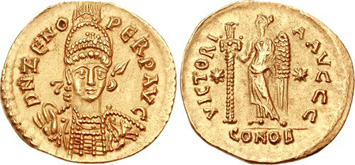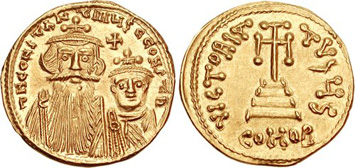Byzantine Rulers You Can Collect, Part I
Posted on 9/21/2010
After the “fall” of the Western Roman Empire in A.D. 476, Roman civilization persisted in the East for yet another millennium, as what modern historians call the Byzantine Empire. For most of that time the Byzantine world was headquartered within the walls of Constantinople, assuring it maintained a distinctly Greek spin on the Roman culture of the Latin West.
Since the Byzantine Empire is the continuance of the Roman Empire, its coinage is more often regarded as ancient than Medieval. In historical terms, though, Byzantine coins are not ancient at all: the empire "began" after the Classical World had ended. It flourished during the Early Middle Ages (“Dark Ages”), High Middle Ages, Late Middle Ages, the Renaissance and survived into the Age of Discovery. The last Byzantine coins were struck less than 40 years before Columbus sailed for America.
Narrowing the list of Byzantine rulers for an overview is no easy task, as we are dealing with a period of about 1,000 years. However, we’ve chosen 20 who rank among the most historically important, and we’ll present them in two columns.

1. Zeno, emperor A.D. 474-475 (first reign) and A.D. 476-491 (second reign). As the emperor who ushered in the Byzantine Empire, Zeno ruled at a critical time in history. A rustic from the region of Isauria, in southeastern Asia Minor, Zeno gained notice through military service and eventually married a daughter of the emperor Leo I (A.D. 457-474), through whom he engineered his rise to supreme power. Zeno was unpopular with aristocrats, and less than three months after being crowned he was ousted in a conspiracy led by his mother-in-law, who replaced him with her brother Basilicus. About 19 months later, however, Zeno was able to return to power. In later years he survived numerous attempts by family members and military leaders to overthrow him. In addition to domestic political enemies, Zeno had to deal with aggressions by Vandals, Goths and Persians, all of which he managed through negotiation and clever military action. His coins follow the long-established pattern of the Roman Empire, exemplified by this gold solidus struck at Constantinople.

2. Anastasius, emperor A.D. 491-518. As a man who rose rather modestly to power through palace service and the clergy, Anastasius was a "surprise" candidate for the throne when the emperor Zeno died in A.D. 491. He was selected by Ariadne, the imperial widow whom he soon married as a necessary political gesture. After dealing with opposition from Isaurian rebels, Anastasius focused on protecting the empire from Bulgars, Persians and the Italian King Theoderic. His Monophysite views, however, conflicted with those who believed in Chalcedonian orthodoxy. This critical schism in the Christian faith would plague the empire for centuries, and during Anastasius’ reign it caused terrifying riots. He was a fiscal conservative who streamlined taxes, and in doing so left a surplus of some 320,000 pounds of gold. Anastasius reformed the coinage, which included the introduction of the large copper “follis” – a coin of the 40 nummus denomination. The example shown here was struck at Constantinople; its obverse is inscribed in Latin, whereas the reverse uses a Greek formula for its denomination (M being the equivalent of 40).

3. Justinian I, emperor A.D. 527-565. Perhaps no Byzantine emperor is more highly esteemed than Justinian I, who in A.D. 527 succeeded his uncle Justin I. His formulation of the Institutes and the Digest of Roman jurisprudence, was of critical value to Roman law. He also commissioned the Church of St. Sophia (the Hagia Sophia) in Constantinople and did much to recompose the former Roman world by recovering territories in Spain, North Africa and Italy. Much like the Roman Emperor Trajan (A.D. 98-117), Justinian accomplished a great deal, even though it was clear afterward that he had overreached with his conquests. His reign was marred by schisms within the Christian faith, difficulties with the Persians and the emergence of the bubonic plague, which taxed the spirit and resources of the Byzantine Empire. The facing portrait of Justinian appears on this copper follis of Antioch, dated to his 13th regnal year, which spanned the years A.D. 539 and 540.

4. Justin II & Sophia, co-rulers A.D. 565-578. One of the more unpopular Byzantine emperors, Justin II does not seem to have had the wisdom or consistency for effective rule. He objected to the idea of paying enemies to remain peaceful, even though the most vigorous of emperors had long considered this a practical necessity. He and his wife Sophia inherited a significant debt from their predecessor, Justinian I (527-565), and had to pursue a conservative financial policy, which saved the empire much grief. But their success in this realm earned them a cynical and undeserved reputation for stinginess. In the ever-thorny realm of religion they engaged in ecclesiastical building projects and increased honors paid to the Theotokos (the Virgin Mary) as protectress of Constantinople. Justin seems to have gone insane toward the end of his life, and was succeeded by his longtime political colleague, Tiberius II Constantine. Justin II and Sophia are shown seated in full imperial regalia on this rare copper half-follis (20-nummi) of Carthage.

5. Maurice Tiberius, emperor A.D. 582-602. The successor of his father-in-law Tiberius II Constantine (A.D. 578-582), Maurice was one of the most effective emperors in Byzantine history, and is venerated as a saint in the Orthodox Church. He inherited much to deal with: poor finances, famine, the plague, religious infighting, aggressive enemies and too vast an empire to rule effectively. Though he lost the Byzantine foothold in Spain, he shored up the more important administrations in Italy and North Africa, and was remarkably successful in dealing with the Persians. He had difficulty, however, containing an invasion of the Balkans by the Avars and Slavs, during which the Avars advanced to the walls of Constantinople. Throughout his reign Maurice had to resort to austere measures to save money. One such effort caused the army he’d led across the Danube to rise in mutiny, and Maurice and his sons were murdered in favor of a junior officer named Phocas. This gold semissis (half-solidus) of Maurice bears a simplistic portrait that is typical of the era.

6. Phocas, emperor A.D. 602-610. Many historians who wrote during the seventh through the 11th centuries traced the decline of the Byzantine Empire to the reign of Phocas. However, he cannot be blamed entirely, as he inherited a difficult state of affairs, including renewed aggressions from the Persians. Worse yet, in 608 Phocas had to withdraw forces from the Persian front to deal with a domestic revolt by the Heraclii, father and son officials in North Africa who quickly expanded their rebellion to Egypt. This allowed the Persians to take Armenia and a string of border fortresses, and caused virtual anarchy in Palestine and Egypt, where soldiers, citizens and clergy caused great atrocities while acting upon vendettas. Phocas, who remained in Constantinople, was murdered after his son-in-law Priscus found it wiser to side with the advancing forces of the Heraclii. The revolt was costly in many ways, leading to the eventual loss of Syria, Palestine and Egypt – first to Persians, and then to Arabs. The facing portrait of Phocas appears on this gold solidus of Constantinople.

7. Heraclius, emperor A.D. 610-641. The long reign of Heraclius was defined by euphoric highs and sobering lows. The brutal rebellion that brought him to power had allowed the empire’s enemies to gain the upper hand, so Heraclius initially ruled over a diminished territory. However, in 622 he went on the offensive. In the midst of this recovery, in 626, a combined force of Persians, Avars, Bulgars and Slavs besieged Constantinople, causing much destruction to its surrounding areas but finding no success. Soon afterward Heraclius defeated the Persians, driving them from Egypt, Syria and Asia Minor, and pursuing them to their capital Ctesiphon. In doing so he was able to return to Jerusalem the Holy Cross that had been seized by the Persians. All of these successes, however, began to unravel near the end of his reign, with the Arabs rising to defeat the Persians. With that buffer removed, Arabs occupied Syria and Palestine, and not long afterward Egypt. This gold solidus shows Heraclius flanked by his sons and successors, Heraclius Constantine and Heraclonas.

8. Constans II, emperor A.D. 641-668. Representing the third generation of the dynasty founded by Heraclius, Constans II was crowned emperor when he was 11 years old. The Arabs were an immediate threat, taking over Egypt and North Africa, much of the eastern lands, and raiding islands off the coast of Asia Minor. Fortunately, internal strife among the Arabs forced a temporary truce, allowing Constans to campaign against Slavs in the Balkans. He transported many of the conquered Slavs to Asia Minor, where presumably they were brought into military service. Late in his reign Constans turned his focus westward, campaigning against the Lombards and shoring up Southern Italy and Sicily, from where he hoped to restore Byzantine influence in North Africa. His efforts in the West incensed many in Constantinople and led to his murder at age 37, which gave rise to the brief usurpation of a court official, Mezizius. Constans’ portrait, shown beside that of his eldest son and principal successor Constantine IV, makes it clear why he earned the nickname pogonata ("the bearded").

9. Constantine IV, emperor A.D. 668-685. Constantine IV and his two younger brothers succeeded their father, Constans II, who was murdered in Sicily in 668. They faced aggressions in the Balkans and in the East, with the situation becoming grave from 674 to 678, when Arabs besieged Constantinople. The secret, combustible "Greek fire" was used to great effect in this conflict. The Arabs eventually withdrew on the promise of an annual tribute of gold, allowing Constantine to liberate Thessalonica from a Slavic siege. Another regional enemy, the Bulgars, however, inflicted a great defeat on the Byzantine army in 680. Internal struggles among the Arabs allowed Constantine to sack cities in the Holy Land and to regain much of Cilicia. On the dynastic front, he eliminated his brothers from the succession by slitting their noses – a form of mutilation that theoretically made them unsuitable to be emperor. He replaced them with his son Justinian II, who at age 17 succeeded him when he died of dysentery at age 35. The facing military bust of Constantine IV appears on this gold solidus.


10. Justinian II, emperor A.D. 685-695 (first reign) and A.D. 705-711 (second reign). The last member of the Heraclian Dynasty, Justinian II succeeded his father, Constantine IV. His first reign lasted a decade, during which he had a fortunate peace with the Arabs and campaigned successfully in the Balkans. However, in 695 a rebellion cost Justinian II his throne; his nose and tongue were slit and he was exiled to Cherson (the Crimea). During his decade of exile Justinian escaped and found refuge with the Khazars and then with the Bulgars, who helped him regain his throne. His second reign was a brutal affair devoted to revenge, which allowed the Arabs to regain lost territories. Justinian was despised for his aggressions, and in 711 a revolt broke among the army he’d sent to Cherson on a punitive expedition. Importantly, he was the first emperor to place on coinage the portrait of Christ: coins from his first reign show a "traditional" Christ pantocrator with long hair and beard, and those of his second reign show a "Semitic" Christ with a curly hair and beard that are closely cropped. Both types are illustrated by these gold solidi.
Photos courtesy of Classical Numismatic GroupStay Informed
Want news like this delivered to your inbox once a month? Subscribe to the free NGC eNewsletter today!